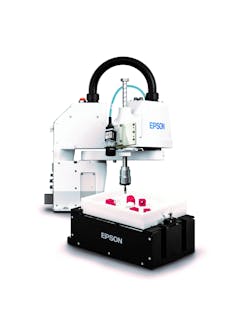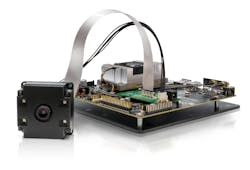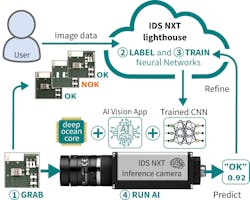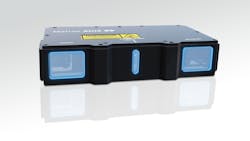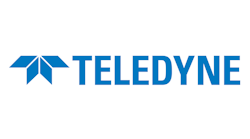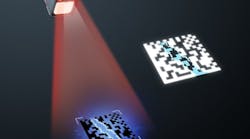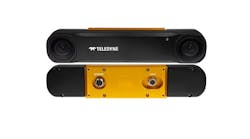Based on the impartial ratings assigned by our panel of judges, awards were assigned in four different levels—Bronze, Silver, Gold, and Platinum, to companies or organizations that demonstrated excellence in a product or technology, an application, or in research and development. Categories to distinguish our honorees include vision systems, four different camera categories, sensors, software, embedded vision, robotics, and more.
Submissions were judged on originality; innovation; their impact on designers, systems integrators or users; whether they fulfilled a new market need; leveraged a novel technology and/or increased productivity.
To celebrate our sixth annual Innovators Awards Program, Vision Systems Design held an online presentation on June 16 highlighting this year’s innovations in machine vision. Our panel of expert judges consisted of systems integrators, consultants, and academics with years of experience in specifying, designing and configuring image processing and machine vision systems. This year’s judges were as follows:
· Tom Brennan President, Artemis Vision (Denver, CO, USA; www.artemisvision.com)
· David Dechow Principal Vision Systems Architect, Integro Technologies (Salisbury, NC, USA; www.integro-tech.com)
· Dr. Daniel L. Lau, Kentucky Utilities Professor and Certified Professional Engineer, Department of Electrical and Computer Engineering, University of Kentucky (Lexington, KY, USA; www.uky.edu).
· Bhaskar Ramakrishnan, Technical Sales Engineer, DWFritz Automation, Inc. (Wilsonville, OR, USA; www.dwfritz.com).
· Robert Tait, Partner at Optical Metrology Solutions LLC (Niskayuna, NY, USA; www.opticalmetrologysolutions.com).
· Rick van de Zedde, Senior researcher / business developer Computer Vision, Wageningen UR Food & Biobased Research (Wageningen, Netherlands; www.wur.nl/en.htm).
· Steve Varga, Principal Scientist, Imaging and Instrumentation R&D, Procter & Gamble USA (Cincinnati, OH, USA; www.us.pg.com).
· Prof. Dr.-Ing. Stefan Werling Baden-Wuerttemberg Cooperative State University Mannheim Mechatronik (Stuttgart, Germany; www.dhbw.de/english/home.html)
· Perry West President, Automated Vision Systems, Inc. (San Jose, CA, USA; www.autovis.com).
· Yury Yakubovich, Founder and President, NSIX Vision Inc. (Markham, ON, Canada; www.nsixvision.com).
· Earl Yardley Director, Industrial Vision Systems Ltd (Oxfordshire, UK; www.industrialvision.co.uk).
Submissions were evaluated for:
- Originality
- Innovation
- Impact on designers, systems integrators, end users
- Fulfilling a need in the market that hasn’t been addressed
- Leveraging a novel technology
- Increasing productivity
Bronze-level honorees
Bronze-level award honorees of our 2020 Innovators Awards Program are as follows (categories in parentheses):
Cadence (San Jose, CA, USA; www.cadence.com): Tensilica Vision Q7 DSP (Embedded vision). The Cadence Tensilica Vision Q7 DSP can deliver 1.82 tera operations per second (TOPS) and addresses vision/image processing, AI processing, and simultaneous location and mapping (SLAM) applications in a single product. This flexible and programmable device can be used in mobile, AR/VR, robotic, drone and automotive applications to offload compute from the CPU or GPU and provide exceptional performance throughput on a platform, according to Cadence.
Epson Robots (Carson, CA, USA; www.epson.com/robots): IntelliFlex Feeding System (Robotics). The Epson IntelliFlex Feeding System (Figure 1) combines an Epson robot, a flexible feeder, and a vision system in one development environment. What would take weeks to integrate a feeder, robot and vision system, now just takes days with the IntelliFlex Feeding System, according to Epson Robots. This reduced development time provides manufacturers operational efficiency with quick part change overs, a smart alternative to parts feeding solutions available in the market today.
HySpex by NEO (Skedsmokorset, Norway; www.hyspex.com): Baldur camera (Cameras – specialty). HySpex Baldur hyperspectral cameras cover three different wavelength range segments from 400 to 2500 nm and, due to its extra light capture, enable high-speed in-line imaging while maintaining better than 1.7 pixels resolution. Baldur cameras are Nyquist cameras offering a spectral resolution of two spectral bands while capturing four times as much light as the classic systems, according to the company. To ensure that the most information per frame is provided, the spectral resolution is kept very close to two bands.
Mitsubishi Electric US, Inc (Cypress, CA, USA; www.mitsubishielectric.com): CIS Wide Format Line Scan Cameras (Cameras – visible). The new KD series contact image sensor (CIS) line scan cameras are wider format models that can image widths of 1064 mm, 1247 mm and 1688 mm. The resolution is 600 pixels per inch and can be reduced to increase scan speed. Additional features include Camera Link or CoaXPress interface, improved 27 mm working distance and depth of field, and a 1:1 telecentric image across the field of view for no image distortion.
Neousys Technology (New Taipei City, Taiwan; www.neousys-tech.com): PB-9250J-SA Series (Embedded vision). Neousys’ PB-9250J-SA is a standalone power backup module that utilizes supercapacitor technology and incorporates a microprocessor for intelligent operation and can operate in the harsh environment from -25°C to 65°C and has a long operating life (10 years or 500,000 charge-discharge cycles).
OmniVision Technologies, Inc. (Santa Clara, CA, USA; www.ovt.com): OX08B Automotive Image Sensor (Image sensors). The OX08B automotive image sensor provides the combination of 8.3 MPixel resolution, 140dB HDR and maximum LED flicker mitigation (LFM). This is, according to OmniVision, the industry’s highest resolution and best HDR, by a significant margin. Additionally, the OX08B provides a new benchmark in LFM performance, enabled by the sensor’s unique on-chip HALE (HDR and LFM engine) combination algorithm, the integration of which was made possible by OmniVision’s 3D stacking technology.
ON Semiconductor (Phoenix, AZ, USA; www.onsemi.com): ARX3A0 CMOS image sensor (Image sensors). The ARX3A0 is a 560 x 560 (0.3 MPixel) CMOS sensor specifically designed to solve the problems of eye tracking inside AR/VR/MR headsets and glasses. It uses a leading edge 2.2 µm back side illuminated pixel with an enhanced near-IR process, improving pixel response by 100% above the 840 nm wavelength light used in eye-tracking applications. With a higher pixel response, fewer near-IR LEDs are needed, achieving lower cost and as the LEDs can also be used at lower power levels, an increase in battery life is also achieved.
Optotune (Dietikon, Switzerland; www.optotune.com) and VS Technology (Tokyo, Japan; https://vst.co.jp/en/): 12mm liquid lens 12MP 1.1" (Lighting, lenses, and optics). This 12mm liquid lens targets image sensors up to 1.1’’ format and 12 MPixel resolution achieving a large, 73° horizontal field of view (HFOV). The lens can focus from 100 mm to infinity, which allows it to overcome the limitations in depth of field (DOF) of standard fixed focal length lenses. The design is optimized for barcode reading in logistics applications such as sorting, bin picking, and palletizing.
Princeton Infrared Technologies (Monmouth Junction, NJ, USA; www.princetonirtech.com): MVCam (Cameras – non-visible). The MVCam series shortwave-infrared (SWIR) and visible InGaAs camera is sensitive in the 0.4 to 1.7 µm wavelength bands, captures 95 fps at 1280 x 1024 resolution, and features 12 µm pixel size. Standard configuration uses a single-stage thermoelectric cooler with no moving parts, integrated into a sealed package to provide a stable 20° C temperature for the image sensor. The camera's PIRT1280A1-12 digital array generates 14-bit digital image data and read noise less than 45 e-.
Radiant Vision Systems (Redmond, WA, USA; www.radiantvisionsystems.com): ProMetric Y43 - 43-Megapixel Imaging Photometer (Cameras – specialty). The ProMetric Y43 imaging photometer is a scientific metrology tool that enables quantification of precise luminance values in displays and illuminated components, beyond the capabilities of other high-resolution imaging systems—most notably, non-photopic (radiometric) machine vision systems, according to the company. The Y43 Imaging Photometer features a 43 MPixel CCD image sensor and includes a PM-IP Imaging Photometer with internal Tristimulus Y filter for photometric measurements and a PM-IR Imaging Radiometer for IR measurements.
ViewOn (Seoul, South Korea; www.view-on.com): Surfi-Inspect (Vision systems). Surfi-Inspect is an inline computational imaging system based on ViewOn’s patented computational illumination device. Surfi-Inspect's image acquisition device consists of a single area scan camera and illumination devices including two bar-type light sources attached perpendicular to the conveyor's moving direction. The camera scans multiple lines at equal intervals for inspection of fast moving objects, which enables multi-view stereo imaging and the lighting sequentially illuminates the object being inspected with various angles, enabling photometric stereo and bright field / dark field imaging techniques.
Vision Research (Wayne, NJ, USA; www.phantomhighspeed.com): Phantom VEO 1310 (Cameras – specialty). The Phantom VEO 1310 high-speed camera is equipped with a 1.2 MPixel CMOS image sensor with 18 µm pixel size. The camera can provide 10,860 fps at full resolution, 14,350 fps at 1280 x 720, 30,030 fps at 640 x 480, or 423,350 fps at 320 x 12. Binning mode, HD-SDI and HDMI outputs, programmable I/O, image-based auto trigger (IBAT), quiet mode, auto exposure, and exposure index are standard features on all models. An optional 10 Gb Ethernet interface is also available.
Silver-level honorees
Silver-level award honorees of our 2020 Innovators Awards Program are as follows (categories in parentheses):
ADLINK Technology (Taipei, Taiwan; www.adlinktech.com): PCIe-GIENVQ, AI Machine Vision Frame Grabber (Frame grabbers and boards). ADLINK’s PCIe-GIENVQ GigE frame grabber targets AI-based machine vision and is a 4-Channel PCI Express GigE frame grabber with PoE functions and an integrated GPU. Powered by NVIDIA Quadro P1000 Pascal architecture technology with 512/1024 CUDA cores, large onboard memory, and advanced display technologies, the PCIe-GIENVQ frame grabber delivers superior performance, more rapid media transfer, and multiple GigE vision connections, according to the company.
ADLINK Technology (Taipei, Taiwan; www.adlinktech.com): Smart Pallet (Vision systems). ADLINK Smart Pallet is a turn-key machine vision AI system designed specifically to help the distribution industry automate packing, palletization and shipping to improve order accuracy and efficiency in a non-disruptive way. Smart Pallet includes ADLINK Neon smart cameras and Edge IoT software for real-time connectivity and apps for AI-based machine vision and connects new and existing equipment, captures multiple image data streams and applies high performance processing power to enable machine learning and inferencing at the edge.
ADLINK Technology (Taipei, Taiwan; www.adlinktech.com): Vizi-AI (Embedded vision). Vizi-AI is ADLINK's award-winning industrial machine vision AI development kit that provides a low-cost entry point to get started with machine vision AI technology. The Vizi-AI starter devkit includes an Intel Atom-based SMARC computer module with Intel Distribution of OpenVINO toolkit and ADLINK Edge software. The dekvit is now available exclusively through Arrow Electronics in the North America and EMEA regions at a special introductory price of $199.
Edmund Optics (Barrington, NJ, USA; www.edmundoptics.com): TECHSPEC CA Series Fixed Focal Length Lenses (Lighting, lenses, and optics). Designed for the 27.9 mm diagonal image circle of APS-C large format image sensors, the TECHSPEC CA series fixed focal length lenses feature a TFL mount with M35 x 0.75 threads and the same 17.5 mm flange distance of a C-Mount. The lenses are available in focal lengths of 50, 75, and 100 mm. The 50 and 75 mm lenses have an f/1.8 – f/16 aperture, and the 100 mm lens has an f/2.8 – f22 aperture. The 50 mm lens has a working distance of 200 mm, and the 75 and 100 mm lenses have a working distance of 500 mm.
Emergent Vision Technologies, Inc. (Port Coquitlam, BC, Canada; www.emergentvisiontec.com): BOLT HB-25000-SB 25GigE Camera (Cameras – visible). Available in monochrome or color versions, HB-25000-SB cameras feature the Sony Pregius X IMX530 sensor, a 24.47 MPixel back-illuminated pixel structure sensor. Through its 25GigE interface, the cameras achieve frame rates of 98 fps at full resolution. Additionally, the cameras feature Mellanox driver support which allows for maximum cameras per PC for substantial cost savings, according to the company.
Keyence Corporation of America (Elmwood Park, NJ, USA; www.keyence.com): 3D Vision Guided Robotic System (Vision systems). Keyence’s 3D vision guided robotic system was designed based on three factors: obtaining a high-quality image, ease of use, and offering a complete solution. The system acquires images using four cameras precisely oriented at different angles with respect to one another to avoid blind spots in bin picking applications. Additionally, this system features simulation software for testing how well taught picks work under expected working conditions as CAD data can be loaded into the software and a bin of randomly oriented parts can be simulated.
LIPS Corporation (Taipei, Taiwan; www.lips-hci.com): LIPS Vision Guided Robot 3D Footwear Automation Solution (Robotics). The LIPS VGR solution for footwear automation consists of robotics, 3D vision, and artificial intelligence technologies that enables shoe sole adhesive bonding automation. The system calculates the glue spraying path in real-time and feeds the results to the robotic arm, which applies glue to various shoe sizes and surfaces.RDI Technologies (Knoxville, TN, USA; www.rditechnologies.com): Iris CM (Vision systems). The Iris CM video-based asset condition monitoring system (Figure 3) connects traditional accelerometers and RDI’s patented video-based vibration measurement to ensure you never miss anything in your plant, according to the company. The system features three USB 3.0 cameras with 2.3 MPixel CMOS sensors that offer multiple views of a process or piece of machinery and can store up to 90 minutes of HD data per camera. Users can trigger video and data recordings based on external inputs, virtual camera-based regions of interest, and thresholds for movement.
Saber1 Technologies (Lowell, MA, USA; www.saber1.com): CXP Multi-Channel Slip Ring (Camera accessories/connectivity). The industry’s first CXP multi-channel CoaXPress rotatory joint (slip ring) transfers up to CXP 12 at 60 RPM. The device can be used in gimbals and robotic applications and transfers CXP signals to a continuously rotating part of an assembly.
SensoPart (Wieden, Germany; www.sensopart.com/en): VISOR Robotic – Vision sensor for vision guided robotics (Cameras – visible). The new software update for the VISOR Robotic vision sensor (Figure 4) includes new robotic functions that simplify use and provide additional flexibility, according to the company. This includes the new Hand-Eye/Base-Eye application-specific calibration methods, in which references in the robot-camera system are numerically determined by taking a calibration plate from different poses and transmitting the robot position to the camera. The new contour 3D detector also enables precise 3D localization based on perspective changes of known contours – in a compact 2D vision sensor.
SOLOMON Technology Corp (Taipei, Taiwan; www.solomon-3d.com): AccuPick 3D (Vision systems). Built on layers of neural networks, AccuPick 3D software recognizes complex products and patterns, with or without their CAD files. The software processes point clouds coming from different types of 3D scanners—structured light, laser triangulation, ToF, active stereo vision, and LiDAR. The software is compatible with over 20 major robot and four key PLC brands and comes with a user friendly, drag-and-drop GUI that requires no programming by the user. The latest AccuPick 3D edition includes automated labeling through photoreal simulation for data acquisition and annotation, making manual labeling unnecessary, while significantly simplifying users’ jobs, according to the company.
SWIR Vision Systems (Durham, NC, USA; www.swirvisionsystems.com): Acuros CQD SWIR Camera (Cameras – non-visible). SWIR Vision Systems has pioneered the development and commercial introduction of high definition, Quantum Dot-based image sensor technology for infrared cameras, delivering higher definition (1920 x 1080 array) and lower cost sensor capability for the SWIR band. Based on sensors with colloidal quantum dot (CQD) thin film photodiodes fabricated on silicon readout ICs, Acuros SWIR cameras, according to the company, became the first commercially available, full HD 1920 x 1080 array camera for the SWIR band.
Teledyne e2v (Chelmsford, Essex, UK; www.teledyne-e2v.com): Emerald 67M image sensor (Image sensors). The Emerald 67M global shutter CMOS image sensor provides customers with ultra-low noise performance and only 2.8e- of readout noise, according to the company. The sensor features a 2.5 µm pixel size, 70% quantum efficiency, an APS-C optical format, up to 72 sub LVDS outputs, and 8/10/12 bit conversion modes. Additionally, the sensor includes a range of application-based features, including region of interest mode, high dynamic range mode, horizontal sub sampling, look-up table, binning, and pixel defect correction.
Tordivel (Oslo, Norway; www.tordivel.no): Scorpion 3D Stinger Food Safe Scanner (Cameras – 3D). The Scorpion 3D Stinger food safe scanner is a 3D color scanner with integrated light sources, cameras, and I/O in an industrial IP67 rated and food safe IP69K housing. The scanner has high dynamic range for working with low contrast surfaces, frame rates up to 3500 fps, encoder-driven image capture, and targets advanced food quality inspection for robot-based applications running on a conveyor.
Tordivel (Oslo, Norway; www.tordivel.no): Scorpion 3D Stinger for Pallet Sorting (Vision systems). The Scorpion 3D Stinger for Pallet Sorting is designed for automatic inspection of pallets used for transportation of food and other goods. The system sorts wooden and plastic pallets based on damage, cleanliness, and appearance. Additionally, the system uses high-resolution color and 3D scanning of all pallet sides, handles multiple pallet types and sizes, and can sort 480 pallets / hour, 24/7, 365 days a year.
XIMEA (Münster, Germany; www.ximea.com): MX377 camera (Cameras – specialty). Targeting scientific imaging applications, the MX377 camera features a PCIe interface, the GSENSE6060 37.7 MPixel sCMOS back-side illumination sensor from Gpixel, 44 fps frame rate, and a quantum efficiency of 95%. The GSENSE6060 data output consists of two readout amplifiers (high and low) providing the possibility of HDR combination with up to 90 dB dynamic range.
Gold-level honorees
Gold-level award honorees of our 2020 Innovators Awards Program are as follows (categories in parentheses):
CCS Inc. (Kyoto, Japan; www.ccs-grp.com) and EFFILUX (Les Ulis, France; www.effilux.com): EFFI-FLEX-HSI Hyperspectral LED Lighting. The EFFI-FLEX-HSI (Figure 5) is a novel broadband VIS-NIR hyperspectral LED illuminator for machine vision and scientific imaging, created from a single continuous-spectrum wideband source. The single broadband LED design allows for relatively flat spectrum between 400 and 900 nm, has high spatial and spectral uniformity, and is suitable for both area scan and line scan hyperspectral imaging applications. Additionally, the lights can be manufactured in unlimited form factors, such as bar lights, line lights, back lights, and projectors, with tunable spectrums.
Cubert (Ulm, Germany; www.cubert-gmbh.com): ULTRIS Light Field Hyperspectral Camera (Cameras-specialty). ULTRIS is a 20 MPixel hyperspectral camera based on light field technology. The camera offers a wavelength range of 450 to 850 nm (100 bands), 2% of center wavelength (sampling 4 nm) spectral resolution, and a spatial resolution of 160,000 per data cube. Data cubes can be readout at up to 6 fps utilizing a dual Gigabit Ethernet interface. No pan-sharpening, no IMU and no post-processing are needed to complete a high-quality spectral image or hyperspectral data cube. With a weight of less than 350 g and a size of 60 x 60 x 57 mm, the ULTRIS allows for easy and comfortable handling, no matter if used in a lab, in the field, or mounted on a small UAS, according to the company.
Headwall Photonics (Bolton, MA, USA; www.headwallphotonics.com): MV.X Hyperspectral Embedded Vision Camera (Embedded vision). The Headwall Hyperspec MV.X features an NVIDIA embedded computing device and solid-state memory inside the IP67-rated housing to perform real-time classification and output results over a GenICam-compliant GigE interface. The camera captures hyperspectral data across the VNIR (400 to 1000 nm) wavelength range across 342 spectral bands with spectral sampling of 1.75 nm/pixel. Additionally, the camera features company designed holographic gratings and aberration-correct concentric optical design, and an efficient passive cooling design.IDS Imaging Development Systems (Obersulm, Germany; www.ids-imaging.com): IDS NXT ocean (All-in-one Inference camera solution) (Vision systems). IDS NXT ocean (Figure 6) lowers the entry barrier and provides easy-to-use tools for creating inference tasks in a few minutes without much prior knowledge and executing them immediately on a camera. The system is based on easy-to-use training software for neural networks, an intelligent camera, and an AI accelerator that executes the neural networks on the hardware side. Users only need sample images and knowledge regarding their evaluation (e.g. good or bad) to create a neural network. This means that deep learning-based image processing for individual applications can now be realized in a very short time by anyone, according to IDS.
Keyence Corporation of America (Elmwood Park, NJ, USA; www.keyence.com): Pattern Projection Vision System (Vision systems). The New Pattern Projection Vision System from Keyence is a 2D and 3D vision system that addresses many issues in the world of machine vision and part inspection. The three issues Keyence wanted to address: stable imaging for complex and challenging inspection applications (addition of 3D height data from a 2D camera), ease of setup for the customer (step-by-step setup menu), and quality inspection for parts of various sizes across all industries.
Matrox Imaging (Dorval, QC, Canada; www.matrox.com/imaging): Matrox AltiZ 3D profile sensors (Cameras – 3D). Featuring a dual-camera, single-laser design, Matrox AltiZ 3D profile sensors (Figure 7) work with Matrox Imaging or third-party machine vision software. The profilers use either red (660 nm) or blue (405) nm lasers and feature GigE Vision interface, and proprietary algorithms running inside the device that automatically generate various types of 3D data—individual profiles, depth maps, or point clouds—obtained by combining or selecting the pixel data from the two integrated image sensors, which is automatically sampled for a constant horizontal resolution. The Matrox AltiZ stands out from other sensors on the market by its dual image-sensor design incorporated into a relatively compact enclosure (233 x 120 x 48 mm), according to the company. With two image sensors viewing the same laser line intersecting the object or scene, the occlusion effect is reduced as previously discussed and illustrated.
ProPhotonix (Salem, NH, USA; www.prophotonix.com): Individually Addressable LED Backlight (Lighting, lenses, and optics). ProPhotonix designed a custom LED SMD-based backlight with hundreds of LEDs that can be implemented with several different LED wavelengths including white, blue and infrared. The system design can be configured for different backlight sizes, for example 1000 mm x 500 mm. The lamps can be run at high power, for example a white LED version has a maximum intensity of 140kLux. An external forced air cooling system provides temperature control. The light is capable of six different strobe patterns in 100µs and complex software structures based on saturated mathematics enable control of the large number of LEDs.
Platinum-level honorees
Platinum-level award honorees of our 2020 Innovators Awards Program are as follows (categories in parentheses):
Teledyne DALSA (Waterloo, ON, Canada; www.teledynedalsa.com): Linea HS 32k TDI camera (Cameras – visible). The new Linea HS 32k camera (Figure 8) uses Teledyne DALSA’s charge-domain CMOS TDI sensor of dual 16k x 64 pixel arrays with a 5x5 μm pixel. It outputs a 32k/2.5 μm super resolution image at 200 kHz line rate, 6.5GB/sec, after data reconstruction in the frame grabber. The super resolution delivers cutting-edge performance for the most demanding automatic optical inspection today. The sensor has unique designs using pixel offset by ½ pixel both horizontally and vertically to achieve super resolution rather than using an actual physical pixel size of 2.5 x 2.5 μm. This design has the following advantages: higher responsibility, higher MTF, lower system costs, and the ability to use existing lighting and 16k/5 μm lenses.

